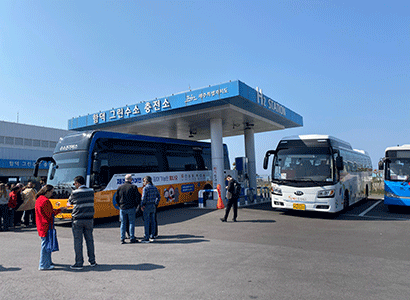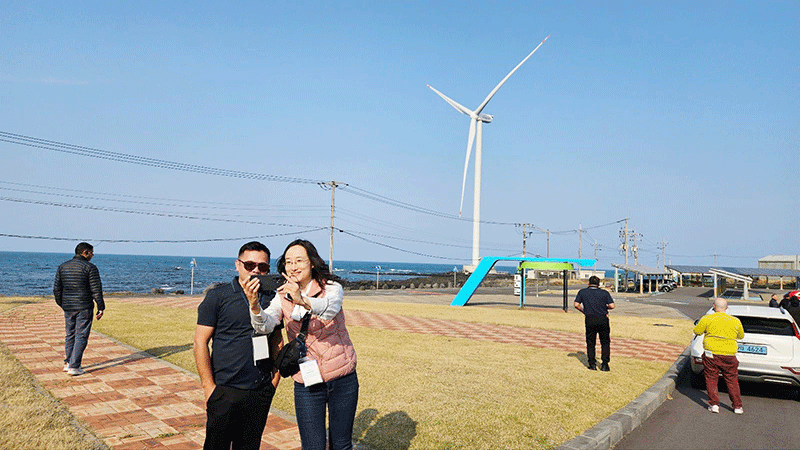 |
| Attendees at the World Journalists Conference pose for a photo at Jeju Stone Park during the Jeju Tour. |
Jeju Island: A harmony of nature, culture, and sustainable innovation
Jeju Island, a jewel in the Republic of Korea, beckons travellers with its breathtaking natural landscapes, rich cultural heritage, and a bold vision for a sustainable future.
With its poetic landscapes shaped by ancient volcanic forces, Jeju is far more than a picturesque island getaway. This 73km-wide and 41km-long oval-shaped treasure, lovingly referred to as the “Island of World Peace”, embodies a global vision: one where humanity thrives in harmony with the Earth.
For travellers seeking both inspiration and tranquility, Jeju offers an experience where every footstep tells a story, every breeze carries history, and every innovation looks to the future.
 |
 |
A weather radar facility.
|
The Hamdeok green hydrogen charging station. |
During the World Journalists Conference 2025, journalists from around the world took part in the Jeju Familiarisation Tour to see the island’s achievements first-hand.
The trip, supported by the Journalists Association of Korea, the Ministry of Culture, Sports and Tourism, the Ministry of Foreign Affairs and the Korea Press Foundation, introduced foreign reporters to South Korea’s culture and development. While many places were included in the itinerary, Jeju clearly stood out.
Amidst global climate change, Jeju Island serves as a global model of abundance and harmonious coexistence and sustainability between humanity and nature. Notably, Jeju announced its ambition to become a “carbon-free island” by 2030 in 2012, three years prior to the Paris Agreement. During a tour, Go Yun Seong, Director of Jeju Special Self-Governing Province, briefed journalists.
He explained that the island’s clean energy strategy sets out four main goals: to produce 100 percent of its electricity from renewable sources; to install 4,085 megawatts of renewable power facilities; to replace 377,000 fuel-powered vehicles with electric ones; and to adopt energy-saving systems that use advanced technology to manage demand.
Progress is already visible. As of 2022, Jeju generated 19.2 percent of its electricity from renewable sources – the highest rate in South Korea. It also leads the country in electric vehicle use, with over 39,000 battery-powered cars in operation, which make up more than 10 percent of the island’s vehicles.
Jeju is now taking the lead in clean hydrogen technology. The Hamdeok Green Hydrogen Charging Station in Jocheon-eup, Jeju-si, is the first of its kind in the country. It uses hydrogen made from renewable energy to power both public buses and private cars.
 |
| Part of the Handam Coastal Trail. |
The station has two hydrogen pumps that can charge four buses and 20 cars per hour. Since August 2023, hydrogen for the station has come from a 3.3 megawatt wind-powered plant in Haengwon-ri. The plant marks a key step in Jeju’s full-cycle green hydrogen system.
Hydrogen buses, often called “driving air purifiers”, use oxygen and hydrogen to make electricity and filter fine dust from the air. The island plans to expand both its fleet of hydrogen vehicles and the number of charging stations as part of its 2035 Net Zero Vision.
Jeju is also building green hydrogen production centres and the CFI Energy Future Hall to support its clean energy goals.
But Jeju is more than a model for clean energy. It is a place where nature, stories and culture live side by side.
One such site is Jeju Stone Park, a cultural space built around the island’s volcanic origin and stone heritage. The park is inspired by Seolmundae Halmang, the goddess of Jeju’s creation, and the Obaek Janggun legend.
Visitors can see stone artefacts once used in everyday life, along with artworks that turn Jeju’s natural stones into sculptures.
The park sits on 300,000 square metres of Gotjawal forest, a volcanic terrain where the natural ecosystem remains untouched. Within the park, the Gyorae Natural Recreation Forest covers a massive 2.3 million square metres.
It features eco-lodging, a camping site, a forest healing zone, and a 3.5km hiking trail through the Keunzigeuri Oreum.
Visitors looking for a peaceful walk by the sea should not miss the Handam Coastal Trail, also known as the Gwakgeum Olle Trail. The 1.2km route follows the shoreline from Aewol Port to Gwakji Gwamul Beach.
It offers clear views of the sea, the sound of waves, and a rugged path shaped by solidified lava. The trail was named one of Jeju’s 31 Hidden Scenic Spots in 2009. Its sunset views and black volcanic rocks offer a unique glimpse into the island’s natural charm.
Jeju is also a hub for innovation in space technology. It is home to CONTEC Company Limited, South Korea’s first space start-up listed on the Korea Securities Dealers Automated Quotations index.
The company designs, builds and runs ground stations for satellites and leads Asia’s only network offering ground stations as a service, with stations in nine countries. Jeju also hosts the Jeju Asia Space Park, the largest privately operated satellite ground station complex in South Korea.
With its green vision, strong culture and breathtaking scenery, Jeju offers something rare – a place where ancient traditions meet bold ideas.
Whether walking beside the sea, hiking through the forest, or learning about hydrogen power, visitors will find beauty and purpose in every corner of the island.
 |
| Conference participants visit green hydrogen production facilities. |
By Phonepaseuth Volakhoun
(Latest Update April 9, 2025)
|






